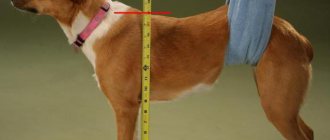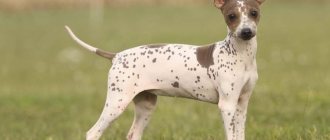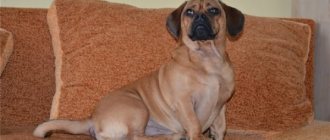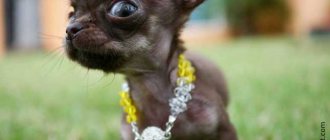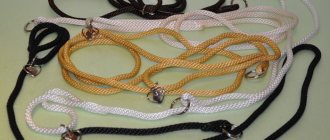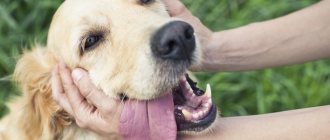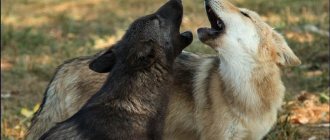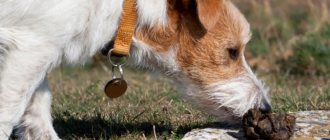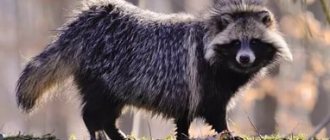04/05/2014 | Views: 7 110
Who among us did not dream of a dog as a child? About the same as the Kid that Carlson flew to. But more often than not, we didn’t get a dog, despite all the pleas, persuasion and oath assurances to feed, walk and wash the pet. Carlson, by the way, didn’t arrive either. This is how my childhood passed, without a dog... And we promised ourselves with all our hearts that when we grow up, our children will certainly have a dog! We have grown up, and it’s time to fulfill the promise we made to ourselves. Moreover, psychologists recommend getting a dog! Having a pet will not only teach your child to care and love others, make him more sociable and responsible, but will also bring the whole family closer together around him, everyone’s favorite one.
Dad likes big dogs, mom likes small dogs. But we choose a friend for a child, and here we need to take into account a lot: the character of the dog, its size, habits. After the release of the cartoon “1001 Dalmatians,” thousands of dads and moms, touched by the heroes of the story, rushed to buy puppies of this breed. A little later, letters of complaint were sent to the studio that made this cartoon - real dogs turned out to be not so cute at all, but rather characteristic creatures. Therefore, you need to approach the issue very seriously, because you are choosing a new family member. But not only the qualities of the dog are important, but also... the age of the child. A child should not buy a dog that is too large: which one was given to whom? Even if she has a very good-natured character, she may simply accidentally knock over the baby. However, tiny dogs like toy terriers, Yorkshire terriers and chihuahuas are not a good choice for small preschool-age children, because children can traumatize these fragile creatures by showing too much affection for them. Although some parents consider them suitable even for children 2-3, it is too early to get a dog, unless, of course, it no longer lives in the family.
Beagle
Newfoundland
Bull Terrier
Spaniels
The most suitable dog breeds as a companion for a small child of primary school age are: bobtail, boxer, cocker spaniel, collie, Larbrador retriever, Newfoundland, German shepherd, royal poodle, St. Bernard, Boston terrier, English bulldog, Bernese mountain dog, beagle, bloodhound, Golden Retriever, Irish Wolfhound, Staffordshire Bull Terrier.
Fox terrier
Yorkshire Terrier
Irish Setter
For older children: Alabai, American Staffordshire Terrier, American Bulldog, Irish Setter, Wire Fox Terrier, Shar Pei, Toy Terrier, Yorkshire Terrier
Collie or Sheltie (small copy of the collie). A nanny dog that can be trusted to look after children. Smart, affectionate to the point of tenderness - ideal company for a child. It is believed that she perfectly understands what the owners are talking about. You shouldn’t punish your child in front of her - she will remember it for you!
Collie
Poodle
The Poodle is a versatile breed of dog, smart, cheerful, well trained in many tricks, and in addition, this breed has the entire “size range” - from a tiny toy poodle, small and medium to a king.
The Labrador Retriever and Golden Retriever are a smiling dog with the sweetest face and a constantly wagging tail, suitable for both toddlers and older children. An excellent playmate who is very careful when playing with small children.
Labrador Retriever
Golden retriever
St. Bernard . Friend and nanny, about whom the well-known film “Beethoven” was shot. Yes, he is exactly like in the film - caring, kind, cozy and... a little slobbery. He is very careful with children, despite his impressive size.
The German Shepherd is a “universal friend”, it is easy to train, easy to raise and easy to care for. In addition, he will always listen carefully to everything the child wants to tell him - you couldn’t find a better interlocutor! Moreover, he is an excellent guard - he will not let strangers near the baby, not for any price of candy.
Saint Bernard
German Shepherd
Bulldogs . Very balanced, calm and loyal dogs. However, you can't find a more fun comrade in games. They are very smart and able to soberly assess the situation. This is both a friend and a protector.
Boxer . The breed is serious and requires mandatory training. A properly raised boxer is loyal to children's amusements and willingly takes part in children's games and cheerful running after each other.
Bulldog
Dogs of the noble breed - that is, ordinary mongrels, a cross between something and who knows what. The gratitude of the mongrel street child simply knows no bounds. A hungry and frozen puppy, after a little adaptation to home conditions, is the most devoted friend, expressing love and gratitude with all its being. They are quite smart and quick-witted and quite amenable to training. Actually, what does a child need to be friends with a dog? Give me a paw, friend!
Noble breed dogs
A child who grows up with a dog receives from it the best lessons in life: a lesson of devotion, a lesson of love, a lesson of fidelity, a lesson of the ability to forgive.
Did you have such a friend in your childhood, and does your child have one?
Source
Origin of the breed
The court terrier is not purebred, that is, there is no pedigree, nor are there parents with titles. Consequently, the name of the breed sounds like “yard”.
Did you know? The ancestors of the dog were wolves; they were the first to be tamed by humans back in the Stone Age (13–7 thousand years BC). Today, about 400 breeds of dogs have been bred on Earth, which are divided into 3 types: decorative, hunting, and service. The Dvorterrier united the qualities of all types of breeds, because he is their ancestor and successor at the same time.
Find out more about hunting dog breeds: Russian-European Laika, Parson Russell Terrier, Russian Spaniel, Thai Ridgeback, Whippet, Welsh Terrier, Afghan Hound, Estonian Hound, Drahthaar, African Non-Barking.
Advantages and disadvantages of mongrels
Among the advantages of the court terrier dog breed:
- good health with good immunity;
- endurance;
- the ability to appreciate good attitude from owners;
- devotion;
- quick adaptation to new conditions and new people;
- individual, unique character that distinguishes this dog from a purebred one;
- huge diversity of genes;
- appearance is always individual;
- does not require high-budget food;
- good security guard;
- A mongrel will always be the beginning of the birth of a new breed of dog, because you can find many invaluable qualities in it.
Flaws:
- mongrels are unpredictable, unlike purebred dogs (some consider this quality a plus);
- not every yard has a prestigious appearance;
- there is no need to expect purebred puppies in the future;
- If you take a puppy, you may not be able to guess the growth characteristics of an adult dog.
Human use of mongrels
Mongrels were often used by humans as guard dogs, as well as in the circus and cinema, for scientific purposes. History knows examples of the use of mongrels in wartime. And, of course, mongrels are known as good companions.
Belka and Strelka
Belka and Strelka are well-known astronaut dogs. For experiments in the field of astronautics in the USSR, only stray mongrels were used, as they were noted for good health, intelligence, undemanding food, and a good attitude towards people. These could be found on the street and taken for free. There were many dog-cosmonauts in the USSR, besides Belka and Strelka, Veterok and Ugolyok, Dezik and Tsygan and others flew into space.
Belka, Strelka and other dogs that have been in space: photo gallery
Belka and Strelka are Soviet cosmonaut dogs who made a space flight on the Sputnik 5 spacecraft on August 19, 1960.
In addition to Belka and Strelka, there were also Chernushka and Zvezdochka - slightly less famous travelers
Currently, stuffed Belka and Strelka are in the Memorial Museum of Cosmonautics in Moscow
Ball
Vladimir Bortko’s film “Heart of a Dog” is familiar to many. The main role of the dog Sharik was successfully played by the mongrel dog Karai.
A monument was erected to Professor Preobrazhensky and Sharik in St. Petersburg
Pavlov's dogs
Scientist Ivan Petrovich Pavlov used yard dogs in his experiments. Pavlov's discovery of the conditioned reflex led to the creation of an entire science - the physiology of higher nervous (mental) activity.
Pavlov became famous for dividing all reflexes into conditioned and unconditioned
What can you tell by the look?
The description of a mongrel breed is always unique in appearance, but the dog will be more similar to a purebred dog, the fashion for which prevails in a given area at a given period of time.
For example, if shepherd dogs are in fashion in a particular area, then there will be a lot of mongrels similar to them. Hounds and hunting dogs will cause the appearance of a similar contingent. And if fashion is out of control, there will be mongrels in every color, size and character you can imagine.
The genetics of a mongrel also affects the variety of puppies from one mother: one may be larger, another smaller, one with floppy ears, and another with erect ears, etc. You cannot say the same about purebred puppies, because everything will be the same for them. And they will also suffer from the same diseases, unlike yard dogs.
What dogs are mongrels
If everything is simple with purebred dogs, then with mixed breeds and mongrels difficulties arise. Officially, when preparing documents, mongrels are called mestizos, but in the field of dog breeding these are different concepts. A mongrel is a mongrel dog that is the result of a mixture of two or more breeds. It is impossible to identify the parents, since the pet does not inherit any obvious signs of purebred companions. A mixed breed is born as a result of crossing two purebred or one purebred and one outbred pet. A dog is called a mixed breed if it has inherited obvious characteristics of one of its parents and secondary characteristics of the other. As a rule, it is easier to trace the pedigree of mixed breeds, since they are born as a result of random matings of purebred companions. In the case of mongrels, this is difficult, and sometimes even impossible.
Character
The dog's agreeableness and strong loyalty are suitable for families with children. Moreover, mongrels love to play, and they have enough mobility for a long time. To release energy, it is best for the Yard Terrier to constantly play in the yard, for which a private property would be a suitable option. Even with a small stature, the dog is able to protect its owners thanks to its quick grasp and courage. The court terrier has a good memory for the good deeds of the owner, so the chance of becoming best friends is great.
Training and education
The dog learns well, so you definitely need to show him what he can and should do, and what he shouldn’t do. The dog's intelligence allows it to understand everything its owner says. You need to talk to your pet about everything. If he carefully observes the actions of the owner, it means he intends to remember them. And as a result, the dog always knows what the owner is doing in the morning, when he is getting ready for work, or, for example, when he returns home.
Did you know?
The level of canine intelligence is equal to the development of a 2-3 year old child. Dogs understand no more than 200 words, the rest they guess from human behavior.
You can teach your court terrier to follow simple commands without any problems. This dog is attentive and has a good memory. If the command is successfully completed, you must reward the animal with something tasty.
Many people are interested in how to raise a mongrel dog. So: to begin the process of education, it is advisable to first find out what breed the crossbreed is from. This will help you understand what data the dog already has at the genetic level, and what still needs to be developed.
Pros and cons of yard dogs
Little mongrels, like any other animal, have both their disadvantages and advantages. The advantages include:
- good health. The mongrel dog is practically not susceptible to hereditary diseases;
- easy adaptation to any conditions;
- ease of training and learning. Such animals completely lack fixed instincts. They are characterized by acute hearing, excellent sense of smell, and good watchdog qualities.
But a yard dog often shows aggression towards other animals.
This is its main disadvantage. Important ! A yard dog has a sharp mind, he has an instant reaction, the ability to instantly assess events happening around him.
Yard dogs become very attached to their new owners
Living and maintenance conditions
Good living conditions must be created for every pet, but with a yard dog it is easier in this regard. She may well live not in a house, but in her own kennel in the yard. The Dvorterrier is hardy and will be quite comfortable in different weather conditions. If winters are always frosty, the kennel should definitely be insulated. Yard dogs are most often kept on private urban property and in rural areas, because there is a lot of free space for them.
And yet, the character, height, weight, health, mood and even beauty of your pet will depend on your living conditions.
In order for the dog to feel comfortable, it is necessary to equip it with an enclosure and a booth.
Care
A purebred dog needs much less care than a purebred dog. She is not picky about food, and it is not at all necessary to buy special food for her. Due to innate immunity, the yard dog generally does not get sick much, although this issue can be controversial due to the conditions of detention: when there is not enough nutrition, the immunity is undermined even in puppyhood.
Unlike a court terrier, a certain breed will always be susceptible to certain diseases, so it needs to be constantly treated, which can cost a lot of money.
As for cleanliness and beauty, in any case you need to take care of a dog of any breed.
Wool
The Dvorterrier has a wide variety of coat types. It needs to be cared for in the same way as certain types of coat in other breeds. It is especially important to comb out shedding fur if someone in the family suffers from an allergy to it.
To clean short hair from dirt, you can use a special metal brush. It must be used carefully so as not to scratch the skin. This procedure can be repeated on clean skin for a massage effect. You can also clean your dog with a vacuum cleaner if it is not afraid of it - this is also suitable for short-haired dogs.
In cases where the coat is of medium length or long, but not hard, a long-tooth comb is used for grooming. In addition to shedding fur, it is good for them to comb out pellets and dirt from the hair. Curly coats need to be both combed and trimmed regularly, as dogs with this type of coat do not shed.
The hardest coat is the most difficult to care for. In addition to combing, such hair may need trimming or trimming - plucking out dead hairs, which also do not fall out during shedding, like other types of hair in dogs. Trimming can be done either at home on your own or in a special hairdressing salon for animals.
Ears, eyes, teeth, claws
There is a yellow coating on a dog's teeth, which can provoke the onset of caries and inflammation of the gums. A special toothpaste and a soft toothbrush can help get rid of plaque. It is enough to brush your teeth once every 7 days. If you have obvious problems with your teeth, it is better to consult a veterinarian.
The same amount of time - once a week - is needed for the procedure of cleansing the ears with a cotton swab with vegetable or petroleum jelly. If there is a lot of dirt in the ears, you can carry out the procedure with a 3% solution of hydrogen peroxide.
Gray discharge is often visible in the corners of a dog's eyes. They need to be washed using the same methods as for humans. To avoid wounds on the paws, you need to constantly remove ice, lumps, and splinters from between your toes. It is better to cut off the claws to prevent them from growing into the paw. It is impossible to cut off the entire claw, because at its base there are blood vessels and nerve endings. If in doubt, you can contact a specialist.
Bathing
You should not bathe your court terrier often, even though he loves water treatments. Just 3-4 baths per year are enough: in spring, autumn, summer. The water temperature should be from 25 to 35 °C; the temperature in the room while washing the dog should be maintained at the same temperature. For washing, you can use laundry or baby soap or dog shampoo. It happens that light-colored dogs have to be bathed more often, and you need to remember that a large number of baths can have a detrimental effect on the condition of the coat. It is necessary to brush your dog after bathing.
Important! It is better to bathe puppies by inserting cotton swabs with Vaseline into their ears to prevent moisture from getting into the ears.
If swimming takes place in a pond in the summer, then you need to remember that the place for this should be below the beach, the water should be running, and the time of swimming should be before meals.
Walks
For a mongrel, walks are of great importance, especially if she lives in an apartment. You need to walk the dog for 0.5 hours or more, at least twice a day - this is in addition to walking for natural needs. In both cases, the dog should be led on a leash and, if necessary, with a muzzle. It is best if the pet lives in a private property and has a constant opportunity to breathe fresh air and play.
After a walk, it is necessary to tidy up the paws, especially if the dog lives in the same room with its owners.
Nutrition
The Dvorterrier is not picky about food, and it is not worth buying special food for it. For normal metabolism in the dog’s body, it is enough to eat the usual porridge, cottage cheese, and meat products twice a day. Changing the number of meals is not advisable. Puppies are fed 5-6 times a day.
Clean water must be present in the diet. You need to calculate its portion according to age: for 1 kg of body weight, a puppy needs to drink 100 ml per day, and an adult court terrier - 50 ml of water.
The variety of products directly depends on the age and health of the dog, and the time of year. The menu of a mongrel puppy will be significantly different from the menu of an old dog, because the first needs to fully develop and grow, consume a lot of protein for “construction,” while the other needs to maintain health and restore tissue cells, produce hormones, antibodies for protection, etc.
If a puppy eats milk, then it is helped by the mother’s immunity with the addition of vitamins, microelements, antibodies, hormones, and the adult dog’s body fights diseases on its own.
Important! Chocolate is very harmful to dogs: due to theobromine in its composition, coma or death can occur.
The way you prepare your dog's food should be considered as it is important to retain all the nutrients. Both boiled and raw foods are suitable for nutrition. The first option is attractive because it destroys helminths, viruses and other pathogens. The second option retains all the proper nutrients. If you are in doubt about what type of food is best for your pet, you should consult your veterinarian. Dog food should not be cold or hot, only warm.
